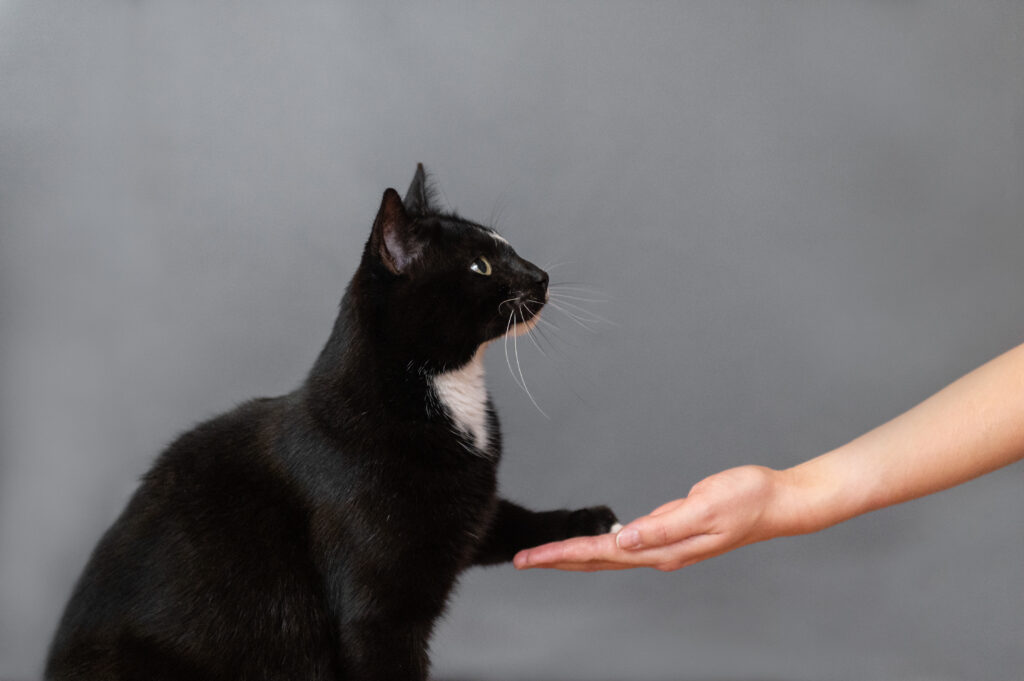How to train a cat?
by Caroline Crevier-Chabot
Can you train cats? Well, for behavior experts, the question seems ridiculous: OF COURSE YOU CAN TRAIN CATS! For the majority of people, however, it still seems improbable. Well, it’s time to set the record straight!

What is training?
Training is teaching. A cat that’s being trained is a cat that is LEARNING to do new things. From an evolutionary standpoint, it makes perfect sense that the myriad of species on the planet is able to learn new things: that’s how they escape from dangers more efficiently, build better shelter, acquire more food and adapt to changes in their environment (weather, change in territory, decrease in the number of prey, etc.). Natural selection has produced species that are best adapted to their current environment AND that are best ABLE to continue to adapt… through LEARNING!
Whether there’s a human with a treat in front of the cat is irrelevant. The environment « trains » the cat constantly.

How does it work?
Since we can’t communicate verbally with our cat to explain to them what we would like them to do, we won’t use speech, but rather:
- An immediate environment that’s set up to make the behavior easy to do;
- Approximations of the final behavior;
- An immediate reward for each approximation!
The more your cat is successful quickly and frequently, the more they will find the activity interesting and will be interested in participating. It will be a game for them… and for you! We want to reward often, often, OFTEN and in order to do that, we need to have set up our cat for easy success so that they can succeed OFTEN!
Rewarding with what?
The easiest and most efficient way to reward your cat is : with a SUPER-MEGA-GOOD treat.
We don’t work for free? Well, our cat doesn’t either.
You can cut up commercial treats like Greenies into smaller bits using a pill cutter from the pharmacy. You can crumble some varieties of Pure Bites treats by hand. You can give small licks of liquid treats from tubes like those from the Inaba Churu brand. A tiny treat is still a treat! By using smaller treats, you will be able to give more rewards and therefore do more repetitions, without filling up your cat’s belly too quickly.
What’s an approximation?
An approximation is a step in the right direction. In order to sit, we first need to move our weight backwards, then bend our legs, then lower our butt, then have our butt touch the chair. Each of these actions is an approximation that we can pay the cat for.
This video shows some possible approximations that one can take to teach a cat to sit by luring them into position through the use of thoughtful treat placement. Each movement is rewarded.
There’s no need to impolitely force the cat into position. We can have fun with them by cheerfully explaining to them what we are looking for. By becoming a better cat trainer, we also widen our skills at teaching the humans around us because we learn to make the task simpler and to see teaching as a challenge to be figured out instead of something that’s frustrating when it doesn’t work.
In this video, we can see some examples of approximations that could be used for a cat that already knows how to give a paw in order to teach them to “High-Five!”. Some cats can do it directly, but if that’s not the case for the cat in front of you, no need to panic! You can simply add approximations of the height of the hand and its position like in the video.
Once the cat has understood what we were looking for, we can modify the signal. In this video, we first lure the cat with a treat to get a full turn, then we use an empty hand, and finally, we diminish the range of our movement. Real training takes more repetitions than this! I’m simply giving you an example here.
It seems easy?
Training is something you learn ! Without a coach to help you to untangle the dead-end in which you feel you’ve run into, you’re more likely to become frustrated and to blame the cat. In truth, if we want the cat to do something, it’s up to us to find the right steps for our cat. Training includes:
- Distant antecedents
- Motivating operations
- Setting up the environment
- Training mechanics
- Coordination
- Approximations
- Proprioception
- Adapting in the moment
- , etc.
You do not become a seasoned trainers in 5 minutes. Give yourself a chance.
Training your cat should be fun. If that’s not the case, it’s only because you need a hand to find the right approximations that are currently missing, which will help you grow as a trainer.
Are you looking for tutorials? I have some in English on my personal YouTube channel. Cat School is also a great place to look.
I’ve also listed some tutorial sources from everywhere in the world here.
You would like to teach your cat to do simple tricks? You’re looking for online coaching? You’re stuck and you want to find out what are the possible paths to solve your struggle? We’re here for you !
To book a coaching session about cat training, click here.
***This type of appointment is NOT suited to behavior issues or for developing a cooperative care plan (nail trims, training for veterinary visits, brushing, medication, etc.***
